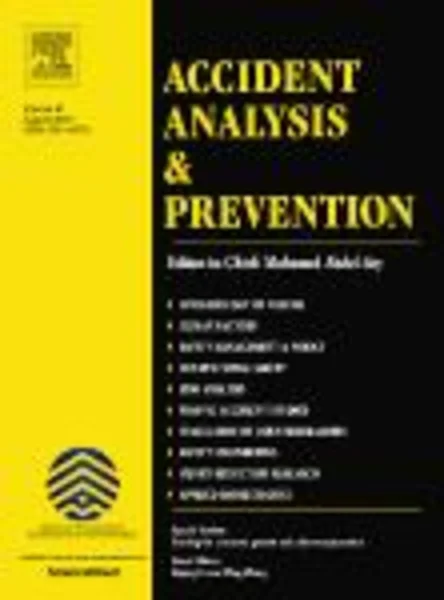-
evaluation of the impacts of traffic states on crash risks on freeways
جزئیات بیشتر مقاله- تاریخ ارائه: 1392/01/01
- تاریخ انتشار در تی پی بین: 1392/01/01
- تعداد بازدید: 859
- تعداد پرسش و پاسخ ها: 0
- شماره تماس دبیرخانه رویداد: -
the primary objective of this study is to divide freeway traffic flow into different states, and to evaluate the safety performance associated with each state. using traffic flow data and crash data collected from a northbound segment of the i-880 freeway in the state of california, united states, k-means clustering analysis was conducted to classify traffic flow into five different states. conditional logistic regression models using case-controlled data were then developed to study the relationship between crash risks and traffic states. traffic flow characteristics in each traffic state were compared to identify the underlying phenomena that made certain traffic states more hazardous than others. crash risk models were also developed for different traffic states to identify how traffic flow characteristics such as speed and speed variance affected crash risks in different traffic states. the findings of this study demonstrate that the operations of freeway traffic can be divided into different states using traffic occupancy measured from nearby loop detector stations, and each traffic state can be assigned with a certain safety level. the impacts of traffic flow parameters on crash risks are different across different traffic flow states. a method based on discriminant analysis was further developed to identify traffic states given real-time freeway traffic flow data. validation results showed that the method was of reasonably high accuracy for identifying freeway traffic states.
مقالات جدیدترین رویدادها
-
استفاده از تحلیل اهمیت-عملکرد در ارائه الگوی مدیریت خلاقیت سازمانی و ارائه راهکار جهت بهبود
-
بررسی تاثیر ارزش وجوه نقد مازاد بر ساختار سرمایه شرکت های پذیرفته شده در بورس اوراق بهادار تهران
-
بررسی تأثیر سطح افشای ریسک بر قرارداد بدهی شرکت های پذیرفته شده در بورس اوراق بهادار تهران
-
بررسی تأثیر رتبه بندی اعتباری مبتنی بر مدل امتیاز بازار نوظهور بر نقد شوندگی سهام با تأکید بر خصوصی سازی شرکت ها
-
تأثیر آمیخته بازاریابی پوشاک ایرانی بر تصویر ذهنی مشتری پوشاک ایرانی (هاکوپیان)
-
تاثیر یک دوره تمرینات پیلاتس بر توانایی فضایی و حافظه کاری زنان سالمند
-
بررسی تاثیر حالت های مختلف قرارگیری آرماتورهای برشی مورب در عملکرد تیرهای بتنی hsc
-
نقش بازاریابی آنلاین بر جذب گردشگر در آژانس های مسافرتی شهر ساری
-
تأثیر سیالات گرمابی در شکل گیری بنتونیت های ناحیه خور و بیابانک (استان اصفهان)
-
gadolinium loaded nanoparticles in theranostic magnetic resonance imaging
مقالات جدیدترین ژورنال ها
-
مدیریت و بررسی افسردگی دانش آموزان دختر مقطع متوسطه دوم در دروان کرونا در شهرستان دزفول
-
مدیریت و بررسی خرد سیاسی در اندیشه ی فردوسی در ادب ایران
-
واکاوی و مدیریت توصیفی قلمدان(جاکلیدی)ضریح در موزه آستان قدس رضوی
-
بررسی تاثیر خلاقیت، دانش و انگیزه کارکنان بر پیشنهادات نوآورانه کارکنان ( مورد مطالعه: هتل های 3 و 4 ستاره استان کرمان)
-
بررسی تاثیر کیفیت سیستم های اطلاعاتی بر تصمیم گیری موفق در شرکتهای تولیدی استان اصفهان (مورد مطالعه: مدیران شرکتهای تولیدی استان اصفهان)
-
بررسی دورنمای فراگیرسازی آموزش و پرورش در ایجاد احساس کارآمدی کودکان با نارسایی ویژه
-
بررسی کفویت در نکاح از دیدگاه حقوق موضوعه ایران
-
واکاوی دیدگاه اخباری ها در مسأله حجیت ظواهر آیات قرآن کریم
-
اثربخشی امید درمانی بر راهبردهای مقابله با استرس و اضطراب کرونا در زنان مبتلا به سرطان پستان در دوران اپیدمی کووید-19
-
(clear-cut, easy and safe air purifying technique (poyrazmatic




سوال خود را در مورد این مقاله مطرح نمایید :